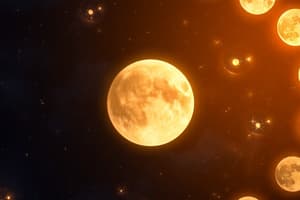Podcast
Questions and Answers
What is the North Star also called?
What is the North Star also called?
- The Morning Star
- The Seven Sages
- The Big Bear
- The Pole Star (correct)
What is the word 'planet' derived from?
What is the word 'planet' derived from?
- A Greek word for 'wanderers' (correct)
- A Roman word for 'celestial body'
- A Greek word for 'star'
- A Latin word for 'earth'
What is the function of the North Star?
What is the function of the North Star?
- To indicate the south direction
- To indicate the north direction (correct)
- To show the pattern of constellations
- To measure the distance of celestial bodies
What is the purpose of the imaginary line drawn joining the pointer stars?
What is the purpose of the imaginary line drawn joining the pointer stars?
What is the Saptarishi?
What is the Saptarishi?
What is the Earth?
What is the Earth?
What is the function of the stars in the night sky?
What is the function of the stars in the night sky?
What is the moon?
What is the moon?
What is the reason why we can't see the moon and other bright objects during the day?
What is the reason why we can't see the moon and other bright objects during the day?
What is the term for the night when the full moon is visible?
What is the term for the night when the full moon is visible?
What are the celestial bodies that are very big and hot, made up of gases, and emit their own heat and light?
What are the celestial bodies that are very big and hot, made up of gases, and emit their own heat and light?
Why do the stars appear as tiny twinkling objects in the night sky?
Why do the stars appear as tiny twinkling objects in the night sky?
What is the purpose of the experiment with the torch and the paper?
What is the purpose of the experiment with the torch and the paper?
What happens to the dots of light on the wall when the lights in the room are switched on?
What happens to the dots of light on the wall when the lights in the room are switched on?
What is the term for the night when the moon is not visible at all?
What is the term for the night when the moon is not visible at all?
What is the common characteristic of the sun and the stars?
What is the common characteristic of the sun and the stars?
Flashcards are hidden until you start studying
Study Notes
Celestial Bodies
- Celestial bodies are objects in the night sky, including the moon, stars, and other shining objects.
- The moon appears at different times, in different shapes and positions, and can only be seen in its full form once a month (Full Moon or Poornima).
- A fortnight later, the moon is not visible at all (New Moon or Amavasya).
- The sun's bright light makes it difficult to see celestial bodies during the day.
Stars and the Sun
- Celestial bodies that are very big and hot, made up of gases, are called stars.
- Stars emit their own heat and light in large amounts.
- The sun is a star, and countless twinkling stars in the night sky are similar to the sun.
- Stars appear tiny because they are very far from us.
Constellations and the North Star
- Constellations are patterns formed by different groups of stars.
- The Saptarishi (Big Bear) is one such constellation, with seven stars that form part of the Ursa Major constellation.
- The North Star (Pole Star) indicates the north direction and remains in the same position in the sky.
- The North Star can be located using the Saptarishi constellation.
Planets and Satellites
- Celestial bodies that do not have their own heat and light, but are lit by the light of stars, are called planets.
- The word "planet" comes from the Greek word "Planetai," meaning "wanderers."
- The Earth is a planet, getting its heat and light from the sun.
- Satellites, like the moon, orbit around planets and are lit by the light of stars.
Studying That Suits You
Use AI to generate personalized quizzes and flashcards to suit your learning preferences.



